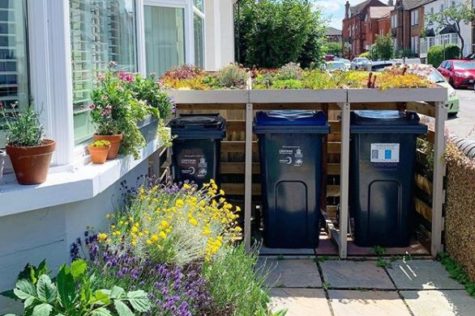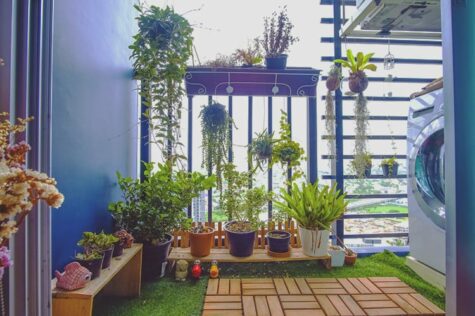Honeysuckle is a classic when it comes to climbers. Selecting a proper trellis for your honeysuckle is very important if you intend to keep this vining plant tamed. For this reason, some might find the task of selecting a trellis quite daunting.
Don’t fret if it scares you too, in this article we will discuss everything you need to know to select the best trellis for your honeysuckle.

Credit: Shutterstock
Selecting a trellis for honeysuckle
Honeysuckle is a very popular climber due to its beautiful, fragrant blooms that lure insects and birds to your garden.
Unfortunately, it can also be quite invasive if not properly cared for, that’s where the trellis comes in. If you want to grow honeysuckle, but you don’t want it to take over your garden, consider the following when selecting the best trellis for your needs:
1. Size
Honeysuckle can turn into quite a big plant. The more space you give it, the more it will grow and it can become quite invasive when used as a ground plant. When grown on a trellis it is much easier to control.
If you want your honeysuckle to create a privacy screen or cover a wall, simply give it lots of room to grow by using a large trellis. If you want it to only cover a small area, use a small trellis and prune any unwanted vines regularly.
2. Shape
Honeysuckle isn’t fussy when it comes to the shape of your trellis. As long as it’s placed in an area with full sun most of the day, you can do just about anything with it.
Here are a few trellis shapes to consider for your garden:
Arches or arbours
Arch-shaped trellises are great for large gardens with walkways. You can also use an arbour to create a shaded area to relax in. Your honeysuckle will quickly cover the whole trellis in a stunning display of fragrant flowers.

Honeysuckle can make an awesome shaded area; credit: Shutterstock
Wall or flat trellises
Wall or flat trellises are great for creating privacy screens and areas with dappled shade. These trellises will also help to protect your walls and other structures against damage caused by climbing vines.

Above the head or on the side, works great both ways; credit: Shutterstock
Pea sticks
Pea sticks are quite commonly used in vegetable patches, hence the name. If you want your honeysuckle to create a little tower of green somewhere in your garden, then they’re a great option. Just keep in mind that they won’t last forever.
Fencing and porches
It’s definitely possible to use existing fences, porches and railings as low budget trellises. If allowed, honeysuckle will quickly take over and cover these structures from the bottom, all the way to the top. It is a great plant to use if you want to hide a hideous fence or a rusty structure.

Hide an ugly fence, or at least make it prettier; credit: Shutterstock
Cages, tripods, obelisk or teepees
These trellises are great for creating a long-lasting tower of green in your garden. Depending on the material used, you might never have to replace it. Just keep in mind that you will need to do some trimming along the ground to stop your honeysuckle from invading the rest of your garden.
Ladders
Ladders are always a good choice for climbers. They can look quite spectacular covered in green. It is also a good way to contain your honeysuckle plant.

Got an old ladder? Repurpose it! Credit: Ourlittleredsaltbox
3. Sturdiness
Sturdiness is one of the most important features when it comes to a trellis. If your trellis can’t support the weight of the plant growing on it, it just won’t do. This is especially important for honeysuckle due to the spectacular size of the areas it can cover in a relatively short amount of time.
4. Material
The material your trellis is made of also plays an important role. Plastic trellises may be a cheap option, but they tend to get brittle when exposed to the sun for long periods of time. Over time, your plastic trellis may collapse under the weight of your honeysuckle.
Wood is a traditional option when it comes to trellises. Wooden structures can be quite strong which makes them ideal for supporting a heavy plant. Just make sure the wood is treated to prevent weather damage that will eventually lead to rot and collapse.
Another material to consider is metal. It is possible to find some beautiful metal structures. Just make sure the metal is treated against rust or a naturally rust-free sort. You should be able to find just about any shape and size trellis in metal.
5. Function
Trellises with honeysuckle growing on them will differ depending on your aim. If you want a privacy screen or wall cover, then a flat trellis is best. If you want to create beautiful arches over walkways then consider an arch. The possibilities are endless, so let your imagination flow.
Positioning your trellis
Honeysuckle isn’t that picky when it comes to where it is placed. Like all plants, however, it will grow towards the sun where possible. You can definitely place your plant in partial shade, but doing so will slow down growing speed as well as reduce the amount and frequency of flowering.
For privacy screens, position your trellis in such a way that when covered by honeysuckle, it will give you the privacy you so desire. If you want to use your trellis as shade, you will need to position it according to the area you plan to shade and the sun’s movement.
Just make sure that no matter where you place your honeysuckle trellis, your plant will always have some time in the sun, even if it’s only dappled sunlight.
Training your honeysuckle
Honeysuckle is very easy to train and will often even train itself. All you have to do is prune away any unwanted vines and weave the rest onto the trellis. It is recommended to prune away thick cover at the base of your plant.
Honeysuckle naturally shades its base, but that leads to new and old growth dying off. In time the base of your plant will start to look ugly if pruning is neglected.
FAQs
Do you need a trellis for honeysuckle?
Honeysuckle doesn’t necessarily need a trellis, but it is much easier to control this plant if you use one. Honeysuckle has a tendency to become invasive if left as groundcover.
Where is the best place to plant honeysuckle?
Honeysuckle grows best if its roots are partially shaded but the vines are left to crawl into the sun. You will also need to make sure that the soil drains really well but still retains some moisture for the plant to use over time.
Is honeysuckle poisonous to pets?
Honeysuckle is known to be toxic to both dogs and cats. The effects and symptoms will, however, differ depending on the species of honeysuckle. For instance, Lonicera spp. is only mildly toxic when ingested in large amounts.

Save this pin for later







I planted my baby honeysuckle last year below a fan shaped wooden trellis. It is growing nicely this year and has climbed up my trellis as I planned. However, now a few of the vines are growing above the trellis. Do I just leave them alone or cut them back to the top of the trellis?
Train it back, add more trellis or trim to keep a maintained look😍
Hi Velma, honeysuckles are fantastic plants, we’re glad yours is thriving. You can trim the honeysuckle to suit your space as needed. The best time to prune is straight after blooming. You can also leave your honeysuckle to do its thing, either way, it’ll do just fine!